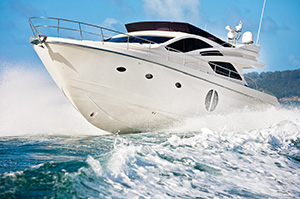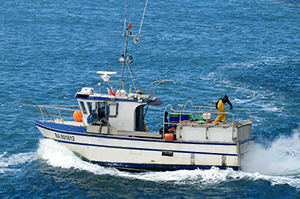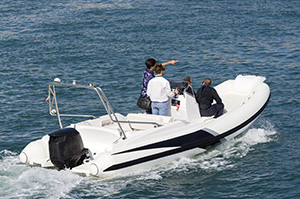



Lecomble & Schmitt
Hydraulic Steering Systems
Lecomble & Schmitt offers hydraulic steering systems for power boats, sail boats, fishing and work crafts. Specifically designed for luxury vessels getting regular and intensive use, Lecomble & Schmitt range of Power Assisted Steering Systems are designed in total compliance with the strictest norms applying to marine equipment.
Reliable
Lecomble & Schmitt "L&S" delivers hydraulic marine steering equipment with the highest level of reliability and function. The design of all Lecomble & Schmitt marine hydraulic products draws on over 70 years of experience in aerospace, industrial, and commercial applications.
Durable and Low Maintenance
Lecomble & Schmitt Marine Steering products are designed to withstand many years of use in a harsh marine environment with very little maintenance. The most common service needed can be completed with a seal kit or other common parts available from us here at PYI Inc., and all over the world.
Power Assisted Hydraulic Steering Systems
Designed for vessels up to 130 feet LOW, Lecomble & Schmitt Power Assisted Steering features smooth operation, steering accuracy and a reduced number of wheel turns to give Lecomble & Schmitt Power Assisted Steering Systems unequalled ease of operation.
Multihull Steering Systems
Lecomble & Schmitt has developed helm pumps, cylinders, components and the expertise needed to become the number one supplier of hydraulic steering systems for catamarans. Multiple steering stations, autopilot pumps, and helm feedback are all available with standard Lecomble & Schmitt equipment.
Outboard Steering Systems
Lecomble & Schmitt offers easy-to-install and easy-to-maintain hydraulic steering systems designed and manufactured with materials to withstand the harsh marine environment and are perfectly adapted to all types of professional or pleasure boating requirements. Our range is the widest on the market, allowing precise selection of the best suited system while maintaining reliability, efficiency and user comfort.
Power Assisted
Hydraulic Steering Systems
Specifically designed for luxury vessels getting regular and intensive use, LS range of Power Assisted Steering Systems is designed in total compliance with the strictest norms applying to marine equipment. The recommended solutions for 185 kpm to 2,000 kpm rudder torque are suitable to equip 15 to 40 meter vessels.
Single Steering Station

Double Steering Station

Pleasure Boat
Hydraulic Steering Systems
The basic setup of a hydraulic steering system for a pleasure boat is:
- 1 cylinder
- 1 manual pump
- Tubing to connect the cylinder to the manual pump
Other elements will be added to this basic setup in function of the number of steering stations or rudders to be operated, and of the installation of a power unit for automatic or non automatic pilot.
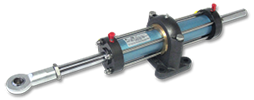
Cylinder
The cylinder is the dictating element towards the selection of a system as it gives the power to the steering system.

Manual Pump
The manual pump is an axial piston pump which makes it possible to suck and force back the oil contained in the circuit when the wheel is turned. Its cubic capacity determines the number of turns required for a lock to lock manoeuvre. The pump is fitted with a lock valve which prevents rudder or motor movement when the helm is not operated. Some models are fitted with pressure relief valves which protect the circuit against abnormal pressure increase.
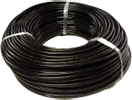
Tubing
Only tubing designed for hydraulic transfer is to be used. The tube diameter is calculated in function of the pump cubic capacity. Maximum efficiency is achieved with inflexible tubing, however flexible tubing may be used for torque levels not exceeding 100kpm.
Workboat
Hydraulic Steering Systems
The basic setup of a hydraulic steering system for a workboat is:
- 1 cylinder
- 1 manual pump
- Tubing to connect the cylinder to the manual pump
Other elements will be added to this basic setup in function of the number of steering stations, the number of outboard motors to be operated and the addition of a power pack for the autopilot.
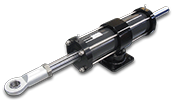
Cylinder
The cylinder is the dictating element towards the selection of a system it gives the power to the steering system.

Manual Pump
The manual pump is an axial piston pump which makes it possible to suck and force back the oil contained in the circuit when the wheel is turned. Its cubic capacity determines the number of turns required for a lock to lock manoeuvre. The pump is fitted with a lock valve which prevents rudder or motor movement when the helm is not operated. Some models are fitted with pressure relief valves which protect the circuit against abnormal pressure increase.

Tubing
Only tubing designed for hydraulic transfer is to be used. The tube diameter is calculated in function of the pump cubic capacity. Maximum efficiency is achieved with inflexible tubing, however flexible tubing may be used for torque levels not exceeding 100kpm.
Outboard Motor
Hydraulic Steering Systems
As a general rule, the basic setup of a hydraulic steering system includes:
- 1 cylinder
- 1 manual pump
- Fittings and tubing to connect the cylinder to the manual pump
Other elements will be added to this basic setup in function of the number of steering stations, the number of outboard motors to be operated and the addition of a power pack for the autopilot.

Cylinder
The cylinder is the dictating element towards the selection of a system it gives the power to the steering system.

Manual Pump
The manul pump is an axial piston pump which sucks and forces back the oil contained in the circuit when the wheel is being operated. Its cubic capacity determines the number of turns required for a lock to lock manoeuvre of the motor(s). The pump is fitted with lock valves to prevent inopportune motor movement when the helm is not operated. The pump is also fitted with pressure relief valves to protect the circuit against abnormal pressure increase.

Tubing
Tubing is designed for hydraulic transfer under pressure and is easily integrated in the installation as a result of its flexibility and small bending radius. Tubing diameter is selected in function of the manual helm pump flow rate.
Models
Select the correct Lecomble & Schmitt hydraulic steering system for your application.
Talk To An Expert!
Want to know which Lecomble & Schmitt hydraulic steering system is for you? Have more questions about Lecomble & Schmitt hydraulic steering systems? Contact us!
Downloads
Need to know more information? Feel free to download our Lecomble & Schmitt brochures, installation instructions and price lists. Can't find what you're looking for? Please contact us!




